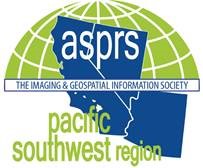
- This event has passed.
Pacific Southwest Region Spring Technical Meeting #2
May 20 2021 @ 7:00 PM - 8:30 PM EDT

Please join the American Society for Photogrammetry and Remote Sensing (ASPRS) Pacific Southwest (PSW) Region of ASPRS on Thursday, May 20th, 2021 for our 2nd Spring Technical Meeting. It will be held over Zoom from 4:00-5:30 pm PDT.
Featuring
4:00 – 4:45
Dr. Michael J. Starek (Texas A&M University – Corpus Christi)
UAS-SfM Surveying of Hurricane Impacts to Little St. George Island, FL
Abstract: The Measurement Analytics Lab with the Conrad Blucher Institute (CBI) for Surveying and Science at Texas A&M University-Corpus Christi has been conducting annual unoccupied aircraft system (UAS) photogrammetric surveys of beach and bay sites along Little St. George Island (LSGI), FL, since 2015. LSGI is a naturally modulating and undeveloped barrier island located along the Panhandle region of Florida’s Gulf Coast. In July of 2018, the team conducted a UAS Structure-from-Motion (SfM) photogrammetric survey of the entire Gulf-facing shoreline of LSGI to derive digital elevation models (DEMs) of the exposed beach and foredune complex to monitor its geomorphic evolution. Approximately 92 days after the UAS survey, Hurricane Michael made landfall as a Category 5 storm near Mexico City, Florida on October 10, 2018. With maximum sustained winds of 72 m/s and 7.2 m NAVD88 high water marks, it resulted in substantial damage and is the strongest recorded storm to hit the Florida panhandle. Although LSGI was spared a direct hit, the proximity of the landfall resulted in substantial coastal erosion of the beach and foredune system. CBI returned in May 2019 to conduct a follow-up UAS-SfM survey of the beach along LSGI to assess damages and examine impacts. This presentation will provide an overview on the implemented UAS surveying approach as well as on SfM photogrammetry to map and monitor beach evolution. Additionally, the presentation will show how the 2018 and 2019 UAS-SfM survey products are being used to quantify the impact to the subaerial beach and foredune system along LSGI including volumetric change detection, shoreline retreat, and geomorphic feature extraction. Finally, other examples on use of UAS to monitor hurricane impacts to natural and built environments along the Texas Gulf Coast will also be presented.
Bio: Dr. Michael J. Starek is an Associate Professor of Geospatial Systems Engineering at Texas A&M University-Corpus Christi (TAMU-CC) and Director of the Measurement Analytics (MANTIS) Lab at the Conrad Blucher Institute for Surveying and Science where he also serves as Chief Scientist. Starek holds a Ph.D. in Civil Engineering from the University of Florida, M.S degree in computer science, and was formerly a National Research Council Postdoctoral Fellow of the U.S. Army Research Office. Dr. Starek’s research explores the merging of geomatics, remote and autonomous sensing, and geospatial computing for monitoring of natural and built environments. As author or co-author, Starek has published over 50 peer-reviewed publications in geospatially centric topics including light detection and ranging (LiDAR) mapping, unoccupied aircraft systems (UAS), and artificial intelligence methods for geospatial data.
4:45 – 5:30
Dr. Ben Vander Jagt (PixElement)
Aerial Trends In Surveying and Mapping: Are New Workflows Overhyped?
Abstract: Aerial Surveying has become an accessible and productive tool in the surveyors growing toolchest. In this presentation, we go over the most recent advancements in aerial surveying and compare them to more traditional workflows to answer the age-old question, is “newer” better? Topics to be covered include aerial photogrammetry with PPK/RTK, Aerial Lidar, and the latest advancements in workflow productivity.
Bio: Ben Vander Jagt is the founder of PixElement. He has an extensive background in Photogrammetry, Computer Vision, and Remote Sensing algorithm development, (phd @ ohio state, ms @ purdue, bs @ ferris state). At PixElement, Ben is responsible for the primary research and development effort and ensuring that customers are satisfied with the reliability, precision, and accuracy of the products that PixElement provides.
There will be time following the presentations for additional Q&A from 5:30-6:00 pm PDT. This will be a great event to learn about current remote sensing, photogrammetry, and GIS research projects and opportunities. We hope you can join us!
